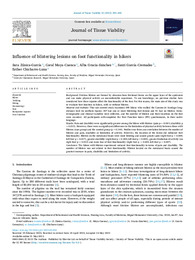Por favor, use este identificador para citar o enlazar este ítem:
https://hdl.handle.net/11000/35002Registro completo de metadatos
| Campo DC | Valor | Lengua/Idioma |
|---|---|---|
| dc.contributor.author | Gracia Sánchez, Alba | - |
| dc.contributor.author | Moya Cuenca, Coral | - |
| dc.contributor.author | Chicharro Luna, Esther | - |
| dc.contributor.author | Zúnica García, Sara | - |
| dc.contributor.author | García Cremades, José Santiago | - |
| dc.contributor.other | Departamentos de la UMH::Ciencias del Comportamiento y salud | es_ES |
| dc.date.accessioned | 2025-01-20T09:33:33Z | - |
| dc.date.available | 2025-01-20T09:33:33Z | - |
| dc.date.created | 2023 | - |
| dc.identifier.citation | Journal of Tissue Viability | es_ES |
| dc.identifier.issn | 1876-4746 | - |
| dc.identifier.issn | 0965-206X | - |
| dc.identifier.uri | https://hdl.handle.net/11000/35002 | - |
| dc.description.abstract | Background Friction blisters are formed by abrasion from frictional forces on the upper layer of the epidermis and can make physical activity an uncomfortable experience. To our knowledge, no previous studies have considered how these injuries affect the functionality of the foot. For this reason, the main aim of this study was to evaluate foot function in hikers, with or without blisters. Material and methods This case-control study examined 298 hikers who walked the Camino de Santiago long-distance trail (in northern Spain); 207 had one or more blistering foot lesions and 91 had no blisters. Sociodemographic and clinical variables were collected, and the number of blisters and their locations on the foot were recorded. All participants self-completed the Foot Function Index (FFI) questionnaire, in their native language. Results Pain and disability were significantly greater among the hikers with blisters (pain p=<0.001; disability p = 0.015). However, there were no significant differences in the limitation of physical activity between those with blisters (case group) and the control group (p = 0.144). Neither was there any correlation between the number of blisters and pain, disability or limitation of activity. However, the location of the lesion did influence foot functionality. Blisters on the metatarsal heads were more limiting and caused greater pain (right foot p = 0.009; left foot p = 0.017), greater disability (right foot p = 0.005; left foot p = 0.005), greater limitation of activity (on right foot p = 0.012) and more loss of foot functionality (right foot p = 0.002; left foot p = 0.007). Conclusion The hikers with blisters experienced reduced foot functionality in terms of pain and disability. The number of blisters was not related to foot functionality. Blisters located on the metatarsal heads caused the greatest increase in pain, disability and limitation of activity. | es_ES |
| dc.format | application/pdf | es_ES |
| dc.format.extent | 6 | es_ES |
| dc.language.iso | eng | es_ES |
| dc.publisher | Elsevier | es_ES |
| dc.relation.ispartofseries | 32 | es_ES |
| dc.relation.ispartofseries | 3 | es_ES |
| dc.rights | info:eu-repo/semantics/openAccess | es_ES |
| dc.rights | Attribution-NonCommercial-NoDerivatives 4.0 Internacional | * |
| dc.rights.uri | http://creativecommons.org/licenses/by-nc-nd/4.0/ | * |
| dc.subject | Blister | es_ES |
| dc.subject | Trekking | es_ES |
| dc.subject | Hiking | es_ES |
| dc.subject | Dermatology | es_ES |
| dc.subject | Pain | es_ES |
| dc.subject | Backpacker injuries | es_ES |
| dc.subject | Foot function | es_ES |
| dc.subject.other | CDU::6 - Ciencias aplicadas::61 - Medicina | es_ES |
| dc.title | Influence of blistering lesions on foot functionality in hikers | es_ES |
| dc.type | info:eu-repo/semantics/article | es_ES |
| dc.relation.publisherversion | https://doi.org/10.1016/j.jtv.2023.05.004 | es_ES |

Ver/Abrir:
Influence of blistering lesions on foot functionality in hikers.pdf
428,15 kB
Adobe PDF
Compartir:
 La licencia se describe como: Atribución-NonComercial-NoDerivada 4.0 Internacional.
La licencia se describe como: Atribución-NonComercial-NoDerivada 4.0 Internacional.
.png)